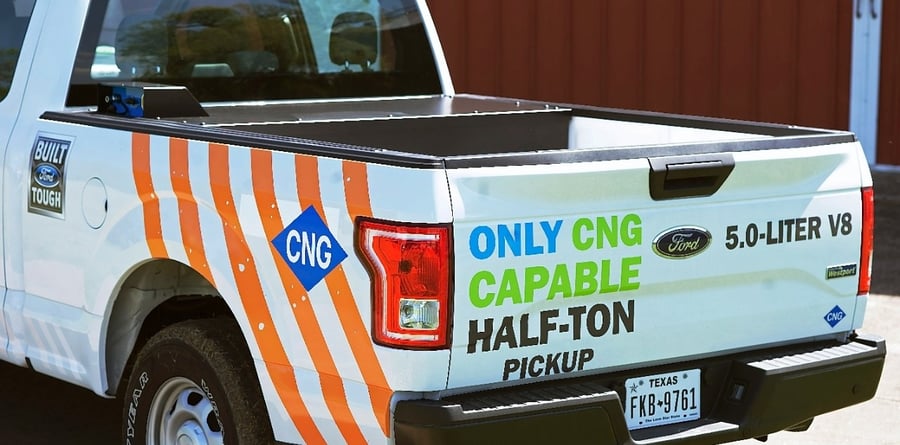This post is one in a series of feature stories on trends shaping advanced energy markets in the U.S. and around the world, drawn from Advanced Energy Now 2015 Market Report, which was prepared for AEE by Navigant Research.

The low cost of natural gas is boosting market acceptance of natural gas vehicles, trucks, and buses, which in turn is increasing demand for the fueling infrastructure to support the growing fleets that use cleaner burning — and increasingly cheaper – natural gas as a transportation fuel.
Compressed natural gas (CNG) can now be used for a variety of vehicles, including cars and light-duty trucks, as well as medium- and heavy-duty trucks and transit buses, which do not travel far from fueling stations. Liquefied natural gas (LNG) is generally used for vehicles that travel longer distances, such as long-haul trucks. The reason for differing applications is that, while LNG holds more energy by volume than CNG, the fueling infrastructure for LNG is more expensive, driven by higher storage tank costs.
Navigant Research estimates there are approximately 23,000 natural gas fueling stations currently installed around the world, and that this could reach 29,000 by 2020. NGV fueling infrastructure already exists in a few countries such as Italy, Germany, Pakistan, and Iran. But in many parts of North America, Western Europe, and Asia Pacific, the development of refueling infrastructure is a key hurdle to growing adoption of these vehicles, particularly by private consumers. It is a chicken-egg dilemma common to alternative fuel vehicles: whether to develop expensive infrastructure while the number of NGVs remains relatively small or wait for additional vehicles on the road prior to infrastructure development. But as lower cost natural gas persists and NGV sales grow, that decision is becoming easier.
Natural Gas Vehicle Fueling Stations (all types)
|
Fuel Delivery |
2011 |
2012 |
2013 |
2014 (estimate) |
|
Fueling Stations |
$2,206 |
$1,926 |
$2,606 |
$2,757 |
|
Fuel Delivery Subtotal |
$2,206 |
$1,926 |
$2,606 |
$2,757 |
(Source: Navigant Research)
Many participants in the infrastructure market are focused on developing CNG fueling infrastructure in cities and suburban areas. CNG is used primarily to serve vehicles that travel within a metro area or between metro areas without refueling, due to shorter vehicle ranges. This infrastructure supports demand for NGVs within metropolitan areas. LNG is marketed as a diesel replacement fuel for vehicles that travel extended distances via known corridors. These corridors, often referred to as the “Natural Gas Highway,” follow existing truck traffic patterns and connect cities. In North America, interstate pipelines for natural gas often follow highway rights-of-way, making for relatively easy access for fueling stations.
In return-to-base-type fleet operations (buses, delivery vehicles, airport vehicles, or garbage trucks), vehicles may only need one fueling point. These fleets can be served by their own dedicated refueling points at the base, without need for public fueling stations. In North America and parts of Western Europe, the growth of NGVs continues to focus on fleets, so, the number of private stations is likely to continue to grow. However, both regions are seeing a push from station operators, natural gas wholesalers, and advocacy groups to make NGV refueling more open to the public.
The market for natural gas refueling stations is growing rapidly but is already crowded, with large, well-funded competitors. Clean Energy Fuels, based in Seal Beach, California, is one of the leading CNG and LNG refueling station installers in the United States. Founded by T. Boone Pickens, the company operates 184 natural gas refueling stations across North America. Blu is an LNG refueling station company based in Utah with stations in Georgia and Idaho, with plans to open 50 new LNG stations by 2015. Blu has begun offering LNG truck rentals in conjunction with PACCAR’s Kenworth brand.
Around the world, natural gas utilities and drilling companies are key players in NGV fueling infrastructure. For example, ENN Energy is a natural gas energy firm that operates more than 238 NGV fueling stations throughout China, in addition to owning natural gas drilling operations and more than 17,000 km (10,563 miles) of natural gas pipelines. Other companies active in the sector include Siemens, Royal Dutch Shell, and Trillium CNG.
The outlook for natural gas fueling stations is bright as costs are coming down and demand for NGVs is going up. When combined with electric vehicle charging (see the Electricity Delivery and Management segment) and, on a smaller scale, hydrogen fueling stations, the range of transportation fuel options is increasing, eating into the market share for diesel and gasoline.
This article is excerpted from Advanced Energy Now: 2015 Market Report. Download the full report by clicking below.
